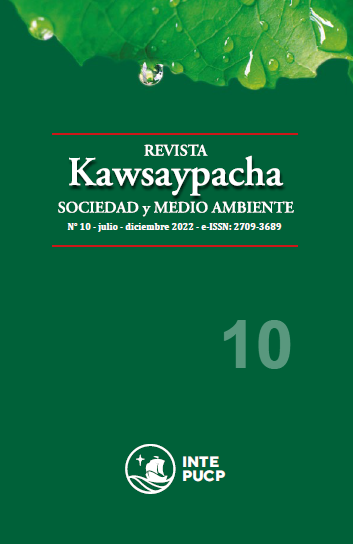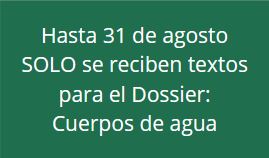La urbanización y la verticalidad de los vínculos rurales-urbanos en las montañas
DOI:
https://doi.org/10.18800/kawsaypacha.202202.011Palabras clave:
Urbanización planetaria, Paisajes urbanos funcionales, Cosmofanía, Montología, SostenibilidadResumen
Las montañas son vistas por lo general como el opuesto rural o incluso «silvestre» de los espacios urbanos. Pero, ¿se puede seguir justificando esta visión en tiempos de la «urbanización planetaria»? ¿Qué es realmente «silvestre», «rural» y «urbano», y en qué se diferencian estas categorías en términos estructurales y funcionales? ¿Existen características urbanas en las montañas? Partiendo de los conceptos de la urbanización planetaria y la verticalidad e incluyendo ejemplos del Norte y del Sur Global, el presente capítulo presenta un tema central de la montología urbana (o la investigación transdiciplinaria de las áreas urbanas de montaña orientada a la sostenibilidad) como es el de los vínculos campo-ciudad entre las diferentes zonas altitudinales. Los vínculos ecosistémicos, infraestructurales, demográficos, económicos y socioculturales en las montañas presentan numerosas especificidades debido al relieve y la altitud del entorno de urbanización. Así mismo, los «flujos» de servicios ecosistémicos en las montañas, los teleféricos que conectan valles y cumbres, la movilidad espacial vertical de las personas, así como el uso deliberado de entornos de montaña e identidades para crear una marca en las ciudades de montaña con el fin de atraer a inversores y visitantes: son sólo algunos ejemplos que subrayan el creciente entrelazamiento de los antiguos contrastes de las ciudades «urbanas» y las montañas «rurales» (o «silvestre»). En este sentido, todo lo anterior mencionado debe tenerse en cuenta en el estudio científico y el desarrollo sostenible de la urbanización de los espacios de montaña para crear lugares habitables para los seres humanos y no humanos.
Descargas
Citas
Aguirre Minvielle, C., & Hermelin, M. (2011). Geometro or how to discover a valley’s geomorphology by an integrated transportation system in Medellin (Colombia). Geoheritage, 3(2), 73-81. https://doi.org/10.1007/s12371-010-0017-6
Augé, M. (1997). Non places. Introduction to an Anthropology of Supermodernity. London: Verso.
Badura, H. (1966). Cerro de Pasco und La Oroya, die Zentren des peruanischen Erzbergbaus. Geographische Rundschau, 18(9), 354-357.
Bailey, R. G. (2009). Ecosystem Geography: From Ecoregions to Sites. New York: Springer.
Bart, F. (2016). Moshi (Kilimanjaro, Tanzania): The urban dynamics of a rural region. In F. Bart, B. R. Nakileza, S. Racaud, & B. Charlery de la Masselière (Eds.), Rural-Urban Dynamics in the East African Mountains (pp. 47-65). Nairobi: Africae, Mkuki Na Nyota.
Benedict, M. A., & McMahon, E. T. (2002). Green infrastructure: Smart conservation for the 21st century. Renewable Resources Journal, 20(3), 12-17.
Berg, L. van den, Drewett, R., Klaassen, L. H., Rossi, A., & Vijverberg, C. H. T. (1982). A Study of Growth and Decline. Oxford: Pergamon.
Bernbaum, E. (1997). Sacred mountains of the world. Berkeley: University of California Press.
Bernbaum, E., & Price, L. W. (2013). Attitudes toward mountains. In M. F. Price, A. C. Byers, D. A. Friend, T. Kohler, & L. W. Price (Eds.), Mountain geography: Physical and human dimensions (pp. 253-266). Berkeley: University of California Press.
Berque, A. (2011). Le rural, le sauvage, l’urbain. Études Rurales, 187(1), 51-61. https://doi.org/10.4000/etudesrurales.9367
Berque, A. (2013). Thinking through landscape. Abingdon: Routledge.
Bhattacharya, N. (2013). Leisure, economy and colonial urbanism: Darjeeling, 1835-1930. Urban History, 40(3), 442-461. https://doi.org/10.1017/S0963926813000394
Borsdorf, A. (2004). Verkehrs- und Städtenetze in Alpen und Anden. Über die Problematik der Übertragbarkeit von Erfahrungen im internationalen Entwicklungsdialog. In W. Gamerith, P. Messerli, P. Meusburger & H. Wanner (Eds.), Alpenwelt – Gebirgswelten. Inseln, Brücken, Grenzen (pp. 299-308). Heidelberg: Deutsche Gesellschaft für Geographie.
Borsdorf, A., & Haller, A. (2020). Urban montology: Mountain cities as transdisciplinary research focus. In F.O. Sarmiento, & L. M. Frolich (Eds.), The Elgar companion to geography, transdisciplinarity and sustainability (pp. 140-154). Cheltenham: Edward Elgar. https://doi.org/10.4337/9781786430106
Branca, D. (2017). Identidad aymara en el Perú. Nación, vivencia y narración. Lima: Editorial Horizonte.
Branca, D. (2019). The urban and the rural in Puno, highland Peru. Anthropology Today, 35(6), 18-20. https://doi.org/10.1111/1467-8322.12542
Branca, D., & Haller, A. (2021a). Urbanization, touristification and verticality in the Andes: A profile of Huaraz, Peru. Sustainability, 13(11), 6438. https://doi.org/10.3390/su13116438
Branca, D., & Haller, A. (2021b). Cusco: Profile of an Andean City. Cities, 113, 103169. https://doi.org/10.1016/j.cities.2021.103169
Brenner, N., & Schmid, C. (2015). Towards a new epistemology of the urban? City, 19, 151-182. https://doi.org/10.1080/13604813.2015.1014712
Byers, A. C., Price, L. W., & Price, M. F. (2013). An introduction to mountains. In M.F. Price, A. C. Byers, D. A. Friend, T. Kohler, & L. W. Price (Eds.), Mountain geography: Physical and human dimensions (pp. 1-10). Berkeley: University of California Press.
Cheng, L. K. P., & Taylor, J. L. (2007). Branding of former soviet cities: the case of Almaty. The ICFAI University Journal of Brand Management, 4(4), 7-13.
Craig, M. P. A., Stevenson, H., & Meadowcroft, J. (2019). Debating nature’s value: epistemic strategy and struggle in the story of ‘ecosystem services.’ Journal of Environmental Policy & Planning, 21(6), 811-825. https://doi.org/10.1080/1523908X.2019.1677221
Dame, J., Schmidt, S., Müller, J., & Nüsser, M. (2019). Urbanisation and socio-ecological challenges in high mountain towns: Insights from Leh (Ladakh), India. Landscape and Urban Planning, 189, 189-199. https://doi.org/10.1016/j.landurbplan.2019.04.017
Dariush, B., Motedayen, H., & Sgard, A. (2020). Landscape Approach to Mountain-City Interaction: The Relationship between Tehran City and the Alborz Mountain Ranges through the Lens of Experts. Bāgh-e Nazar, 17(82), 33-42. https:// doi.org/10.22034/bagh.2019.170465.3981
Debarbieux, B. (1998). The Mountain in the City: Social Uses and Transformations of a Natural Landform in Urban Space. Ecumene, 5(4), 399-431. https://doi.org/10.1177%2F096746089800500402
Della Dora, V. (2016). Mountains: Nature and culture. London: Reaktion Book.
Delorme, F. (2014). Du village-station à la station-village. Un siècle d’urbanisme en montagne. In Situ, 24, 1-18. https://doi.org/10.4000/insitu.11243
Descola, P. (2015). Más allá de la naturaleza y la cultura. In L. Montenegro Martínez (Ed.), Cultura y naturaleza: Aproximaciones a propósito del bicentenario de la independencia de Colombia (pp. 54-77). Bogotá: Jardín Botánico de Bogotá José Celestino Mutis.
Döhren, P. von, & Haase, D. (2015). Ecosystem disservices research: A review of the state of the art with a focus on cities. Ecological Indicators, 52, 490-497. https://doi.org/10.1016/j.ecolind.2014.12.027
Donoso-Correa, M. E. & Sarmiento, F. O. 2019. Geospatial Memory and Joblessness interpolated: International migration oxymora in the city of Biblián, Southern Ecuador. American Journal of Geographic Information System, 8(2), 60-88.
Donoso, M., & Sarmiento, F.O. (2021). Changing Mountain Farmscapes: Vulnerability and Adaptation in the Paute’s Watershed, Southern Ecuador. Journal of Mountain Science, 18(7): 1902-1919. https://doi.org/10.1007/s11629-020-6127-y
Doxiadis, C. A. (2005). Ecumenopolis: the coming world-city. Ekistics, 72(430-435), 189-206. https://doi.org/10.53910/26531313-E200572430-435171
Fernández Cavia, J. (2011). Ciudades, regiones y países como marcas: luces y sombras del place branding. In J. San Eugenio (Eds.), Manual de comunicación turística: De la información a la persuasión, de la promoción a la emoción (pp. 103-113). Barcelona: Documenta Universitaria.
Garriga Bosch, S. (2012). El Tibidabo i la concepció metropolitana de Barcelona. Barcelona: Universitat Politècnica de Catalunya.
Grêt-Regamey, A., Brunner, S. H., & Kienast, F. (2012). Mountain Ecosystem Services: Who Cares? Mountain Research and Development, 32(S1), S23-S34. https://doi.org/10.1659/MRD-JOURNAL-D-10-00115.S1
Haller, A., Andexlinger, W., & Bender, O. (2020). City profile: Innsbruck. Cities, 97, 1-10. https://doi.org/10.1016/j.cities.2019.102497
Haller, A. (2014). The «sowing of concrete»: peri-urban smallholder perceptions of rural-urban land change in the Central Peruvian Andes. Land Use Policy, 38, 239-247. https://doi.org/ 10.1016/j.landusepol.2013.11.010
Haller, A., & Borsdorf, A. (2013). Huancayo Metropolitano. Cities, 31, 553-562. https://doi.org/10.1016/j.cities.2012.04.004
Haller, A., & Borsdorf, A. (2021). Montología urbana: ciudades de montaña como enfoque de investigación transdisciplinaria. Cuadernos de Geografía, 30(2), 509-523. https://doi.org/10.15446/rcdg.v30n2.92865
Haller, A., & Córdova-Aguilar, H. (2018). Urbanization and the advent of regional conservation: Huancayo and the Cordillera Huaytapallana, Peru. eco.mont, 10(2), 59-63. https://doi.org/10.1553/eco.mont-10-2s59
Haller, A., & Branca, D. (2020). Montología: una perspectiva de montaña hacia la investigación transdisciplinaria y el desarrollo sustentable. Revista de Investigaciones Altoandinas, 22(4), 312-322. https://doi.org/10.18271/ria.2020.193
Hommes, L., & Boelens, R. (2018). From natural flow to ‘working river’: hydropower development, modernity and socio-territorial transformations in Lima’s Rímac watershed. Journal of Historical Geography, 62, 85-95. https://doi.org/10.1016/j.jhg.2018.04.001
Ives, J.D., Messerli, B., & Rhoades, R. E. (1997). Agenda for sustainable mountain development. In B. Messerli, & J. D. Ives (Eds.), Mountains of the world: A global priority (pp. 455-466). New York: Parthenon.
Kadykalo, A. N., López-Rodriguez, M. D., Ainscough, J., Droste, N., Ryu, H., Ávila-Flores, G., et al. (2019). Disentangling ‘ecosystem services’ and ‘nature’s contributions to people’. Ecosystem and People, 15(1), 269-287. https://doi.org/10.1080/26395916.2019.1669713
Kapos, V., Rhind, J., Edwards, M., Price, M. F., & Ravilious, C. (2000). Developing a map of the world’s mountain forests. In M. F. Price, & N. Butt (Eds.), Forests in Sustainable Mountain Development: A State-of-Knowledge Report for 2000 (pp. 4-9). CAB International. https://doi.org/10.1079/9780851994468.0004
Kenny, J. T. (1995). Climate, Race, and Imperial Authority: The Symbolic Landscape of the British Hill Station in India. Annals of the Association of American Geographers, 85(4), 694-714. https://doi.org/10.1111/j.1467-8306.1995.tb01821.x
Leibler, L., & Brand, P. (2012). Movilidad e inclusión social: la experiencia desde la periferia de Medellín y el primer Metrocable. Bulletin de l’Institut Français d’Études Andines, 41(3), 363-387. https://doi.org/10.4000/bifea.147
Löffler, R., & Steinicke, E. (2007). Amenity Migration in the U.S. Sierra Nevada, Geographical Review, 97(1), 67-88. https://doi.org/10.1111/j.1931-0846.2007.tb00280.x
Lowe, D., Williams, S., Leigh, H., Connort, C. B., Gemmel, J. B., & Stoiber, R. E. (1986). Lahars initiated by the 13 November 1985 eruption of Nevado del Ruiz, Colombia. Nature, 324, 51-53. https://doi.org/10.1038/324051a0
Mathieu, J. (2011). The third dimension. A comparative history of mountains in the modern era. Cambridge: The White Horse Press.
Milan, A., & Ho, R. (2014). Livelihood and migration patterns at different altitudes in the Central Highlands of Peru. Climate and Development, 6(1), 69-76. https://doi.org/10.1080/17565529.2013.826127
Milman, A., & Zehrer, A. (2018). Exploring visitor experience at a mountain attraction: The Nordkette mountain in Tirol, Austria. Journal of Vacation Marketing, 24(2), 172-196. https://doi.org/10.1177/1356766717691805
Nakamaki, T. (2002). A Geographic Study of the Modernization of Transportation and Changes in Mountainous Villages: A Case of Takayama Area, Fujioka-shi, Gunma Prefecture. Geographical Review of Japan, 75(7), 492-507. https://doi.org/10.4157/grj.75.492
Neumann, E. (1999). The past, present, and future of urban cable propelled people movers. Journal of Advanced Transportation, 33(1), 51-82.
OCDE (2013), Rural-Urban Partnerships: An Integrated Approach to Economic Development. OECD Rural Policy Reviews, OECD Publishing, Paris. https://doi.org/10.1787/9789264204812-en
Oliver-Smith, A. (1979). The Yungay Avalanche of 1970: Anthropological Perspectives on Disaster and Social Change. Disasters, 3(1), 95-101. https://doi.org/10.1111/j.1467-7717.1979.tb00205.x
Perlik, M. (2011). Alpine gentrification: The mountain village as a metropolitan neighbourhood: new inhabitants between landscape adulation and positional good. Revue de Géographie Alpine, 99(1), 1-16. https://doi.org/10.4000/rga.1370
Price, M., Kohler, T., Wachs, T., & Zimmermann, A. (Eds.). (2001). Mountains of the world: Mountains, energy, and transport. Bern: Mountain Agenda.
Pokorny, J. (1959). Indogermanisches etymologisches Wörterbuch. Bern: Francke.
Polderman, A., Haller, A., Viesi, D., Tabin, X., Sala, S., Giorgi, A., et al. (2020). How Can Ski Resorts Get Smart? Transdisciplinary Approaches to Sustainable Winter Tourism in the European Alps. Sustainability, 12(14), 5593. https://doi.org/10.3390/su12145593
Prados Velasco, M. J. (Ed.). (2008). Naturbanization. New identities and processes for rural-natural areas. CRC Press. https://doi.org/10.1201/9780203881149
Rhoades, R. E. (2007). Whither montology? In R. E. Rhoades, Listening to the mountains (pp. 173–184). Dubuque: Kendall/Hunt Publishing Company.
Said, M., Hyandye, C., Komakech, H. C., Mjemah, I. C., & Munishi, L. K. (2021). Predicting land use/cover changes and its association to agricultural production on the slopes of Mount Kilimanjaro, Tanzania. Annals of GIS, 27(2), 189-209. https://doi.org/10.1080/19475683.2020.1871406
San Eugenio Vela, J. de (2013). Fundamentos conceptuales y teóricos para marcas de territorio. Boletín de la Asociación de Geógrafos Españoles, 62, 189-211. http://doi.org/10.21138/bage.1575
Sarmiento, F. O. (1999). To Mt. Chimborazo: in the steps of Alexander von Humboldt. Mountain Research and Development, 19(2), 77-78.
Sarmiento, F. O. (2020). Montology manifesto: echoes towards a transdisciplinary science of mountains. Journal of Mountain Science, 17, 2512-2527. http://doi.org/10.1007/s11629-019-5536-2
Scharr, K., & Penz, H. (2021). Andamento e distribuzione altimetrica della popolazione 1869-2001. In R. Taiani, & M. Wedekind (Eds.), La Regione Trentino-Alto Adige/Südtirol nel XX secolo. 3: L’oggetto popolazione (pp. 203-221). Trento: Fondazione Museo Storico del Trentino.
Schirpke, U., Scolozzi, R., Dean, G., Haller, A., Jäger, H., Kister, J., et al. (2020). Cultural ecosystem services in mountain regions: Conceptualising conflicts among users and limitations of use. Ecosystem Services, 46, 101210. https://doi.org/10.1016/j.ecoser.2020.101210
Seppelt, R., Dormann, C. F., Eppink, F. V., Lautenbach, S., & Schmidt, S. (2011). A quantitative review of ecosystem service studies: approaches, shortcomings and the road ahead. Journal of Applied Ecology, 48(3), 630-636. https://doi.org/10.1111/j.1365-2664.2010.01952.x
Shiji, C., Dhakal, S., & Ou, C. (2021). Greening small hydropower: A brief review. Energy Strategy Reviews, 36, 100676. https://doi.org/10.1016/j.esr.2021.100676
Stadel, C. (1986). Urbanization and urban transformation in a mountain environment: The case of the European Alps. In C.S. Yadav (Ed.), Comparative urbanization: City growth and change (pp. 39-59). Concept: New Delhi.
Tacoli, C. (Ed.). (2006). The Earthscan Reader in Rural–Urban Linkages. Abingdon: Routledge. https://doi.org/10.4324/9781315800486
Tansley, A. G. (1935). The Use and Abuse of Vegetational Concepts and Terms. Ecology, 16(3), 284-307. https://doi.org/10.2307/1930070
Troll, C. (1939). Luftbildplan und ökologische Bodenforschung. Ihr zweckmäßiger Einsatz für die wissenschaftliche Erforschung und praktische Erschließung wenig bekannter Länder. Zeitschrift der Gesellschaft für Erdkunde zu Berlin, 7/8, 241-256.
Tuan, Y. F. (2013). Romantic geography: In search of the sublime landscape. Madison: University of Wisconsin Press.
Zelinsky, W. (1971). The Hypothesis of the Mobility Transition. Geographical Review, 61(2), 219-249. https://doi.org/10.2307/213996















